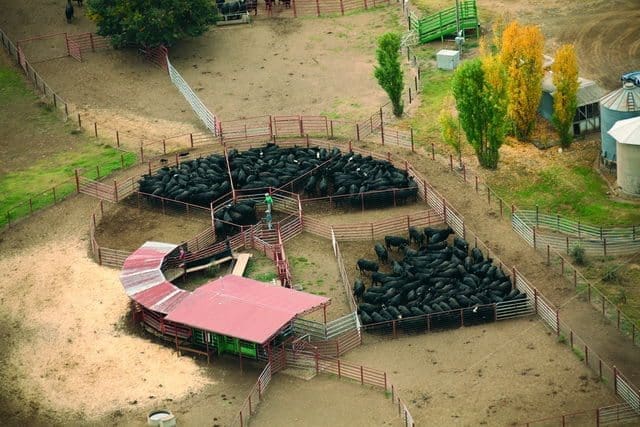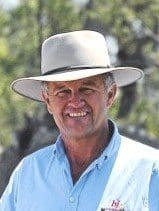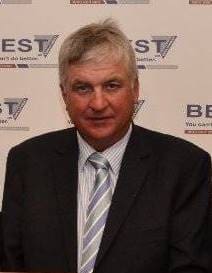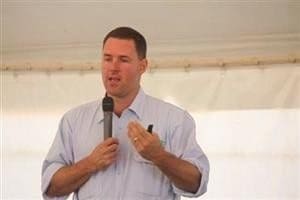
Cattle handling facility on Newstead, near Inverell, bought recently by Paraway Pastoral
THE recent sales of large-scale cattle operations in the New South Wales Northern Tablelands region has reinvigorated interest in local properties, with a strong jump in values for quality, high-rainfall country.
The spark follows the acquisition of seven properties within the region by Paraway Pastoral Company in a deal worth more than $100m.
Paraway started its ‘run’ in investment in the region back in January, securing 4100ha Aberbaldie Station, a breeding and finishing property near Walcha.
As discussed in this property article last week, that has recently been expanded to include the Burmah Station finishing aggregation, 4200ha near Graman, and other nearby assets including Aracoola Spring. A fourth nearby property is understood to be close to settlement.

Bob Jamieson
Inverell-based agent Bob Jamieson, principal of Bob Jamieson Agencies, said the sale of the highly-improved Inverell district properties Newstead and Paradise to Paraway had “pushed up Northern Tablelands cattle property prices by 20 percent overnight.”
“The 12,200ha of country in Newstead and Paradise, previously owned by Neil Statham’s Sundown Pastoral, has a strong dual-purpose component,” Mr Jamieson said.
“Farmers can crop it if prices are good, or they can grow high-quality forages and finish steers.”
“More buyers are becoming aware of the region’s better quality soils, milder climate and higher rainfall. There is strong inquiry for cattle fattening, as opposed to grazing, because of the quality of the country and reliability of rainfall.”
As recently as two years ago, vendors seeking $6000 per hectare for (better quality basalt) breeding country were accepting $5000/ha just to entice buyers, Mr Jamieson said.
“Today, based on recent sales, that figure has risen to $7000 to $8000/ha,” he said.

Phillip Frame
Philip Frame from Frame Rural Agencies at Inverell, who negotiated the recent sale of the two Sundown Pastoral Co owned properties to Paraway, agrees that the Northern Tablelands is setting new price levels, but said it was somewhat dependant on a property’s improvements, such as yards, fences, water and fertilised pastures.
“The country further north (of Inverell) is achieving less per breeding area because it doesn’t have the improvements that the Northern Tablelands boasts,” he said.
Mr Frame said interstate interest in the region was due to its better climate.
“Queensland graziers who have suffered drought over the last three to four years want higher and safer rainfall. That is why they are looking at the Northern Tablelands and the New England.”
Higher, more reliable rainfall attraction
Mr Jamieson said local enquiry was also strong.
“Some farmers with aggregations in the Moree district are looking for a surer income. They have the same quality soils, but are looking for country with better rainfall. Surprisingly, there’s some concern about climate change. For example, I have a client from Moree who is in the process of purchasing a $10m enterprise near Inverell. He believes climate change is real, and sees this area as providing some insurance.”
The question that begs to be asked is whether beef is still viable when $6420 is paid for a hectare of quality finishing country on the tablelands?
Mr Jamieson, who sold the Burmah aggregation to Paraway, explains the company is a very progressive operation.
“It does not do a single thing unless it has done all its sums. It has calculated the returns and the returns are feasible.”
Mr Frame said the recent record price paid by Paraway was viable, even with the current high cattle prices.
“Sundown was able to tell the company how many kilos per hectare it was producing over the past five years. Not many people (vendors) are able to do that. It’s not how many cattle you can run, it’s how many kilos of beef that can be produced per hectare, and that was the deciding factor for Paraway.”

Alastair Rayner
Livestock consultant Alastair Rayner has been committed to the beef industry for 20 years. The principal of RaynerAg in Tamworth, he said the number of head a place runs is “almost irrelevant.”
“In terms of beef production, what drives profitability is the kilos of beef that you produce. The biggest variable is always the cost of production, so rather than talking about per head, people should look at average cost of production and the average price per kilo of beef produced.”
Mr Rayner said there is no doubt Paraway has made a long-term investment.
“The Stratham properties are very well established in terms of infrastructure, fencing and laneways. It’s not just the country Paraway is buying. It is a viable asset that’s been ramped-up in the last 10 to 15 years to be a major beef production business. The family (vendors) has invested money into years of pasture improvement at both Newstead and Paradise and that is what has underpinned the sale at this price.”
Mr Frame believes current land values in the Northern Tablelands are sustainable.
“Cattle are a far more attractive option because there is a good return presently, compared to farming. Grazing country is making more than farming country. Graziers are looking for cattle country, not sheep country where land values have stayed the same. Cattle country with higher rainfall is being rewarded.”
And Mr Frame said higher land values and pending retirement were prompting some landholders to seriously consider selling up.
“The average age of the man on the land is about 61 or 62 years. They’ve been there for a long time and they can sell out and get a substantial amount of money to retire on,” he said.
Mr Jamieson said there are some very high quality places on the New England coming on the market – places that would not normally be for sale.
“All of a sudden the money is enough to tempt people to sell them. While there has been a massive jump in value, virtually overnight, it is important to note that values in our district haven’t moved in six to eight years.”
Mr Jamieson said traditionally, farmers on the NSW Northern Tablelands purchased grain or cultivation country to achieve maximum returns.
“Now, with cattle values rising strongly and wheat prices falling, grazing is a better business, and that has never been the case before in this area. Cattle are overpriced, but are likely to stay that way in the short term. It will be interesting how these new grain values compare to cattle values over the longer term,” he said.
Mr Jamieson suggested it was time for local Australian superannuation companies to wake up and follow the lead of foreign investors.
“They need to look at the consistent returns available and the capital gain in cattle land assets like these. It is the common sense bet for a long term operation,” he said.
